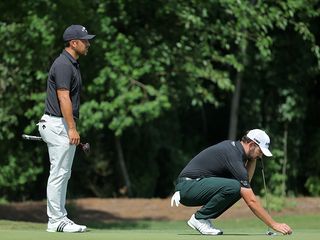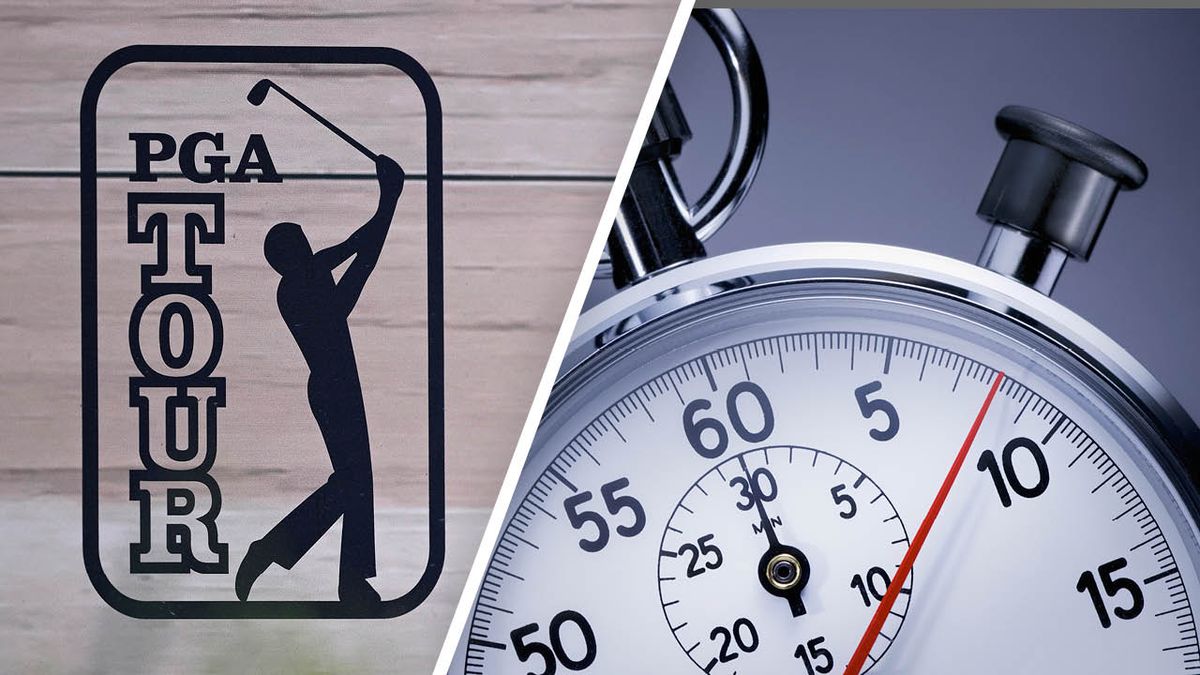Pace of play in golf is a widely-discussed topic, with slow play in particular the source of many conversations in clubhouses across the world. For those attending or watching televised competitive golf at the highest level, it can be frustrating to see elite players taking an age to hit their shots… and often appear to get away with it.
The PGA Tour is attempting to tackle this issue through its pace of play policy, shared in the player handbook. After taking some time to read this, however, I am beginning to understand why we see so few penalties given for slow play…
PGA Tour Pace Of Play Policy
The PGA Tour pace of play policy states that “The player should play at a prompt pace throughout the round”, but as someone who follows the coverage closely on a weekly basis, I would argue this isn’t the case for many.
Allegations of slow play have been pointed towards the likes of Patrick Cantlay, Brian Harman and even recent PGA Champion Xander Schauffele, but what exactly does the policy define as slow play?
Firstly, groups are assessed as to whether they are ‘out of position’. This is explained in the policy as:
“The first group to start will be considered out of position if, at any time during the round, they exceed the time allotted to play, as detailed on the applicable course’s Pace of Play Chart.
“Any subsequent group will be considered out of position if, at any time during the round, they exceed the allotted time to play, and: a) reach a par-3 hole that is open and clear of play, or b) reach a par-4 hole and have not played a stroke from the teeing area before the hole is open and clear of play, or c) reach a par–5 hole and all players have not played a stroke from the teeing area before the hole is open and clear of play.”
That all seems fairly reasonable and easy to follow. Perhaps some improved communication to fans on the course, or watching on television, to indicate a group has been placed ‘on the clock’ would help to alleviate frustrations further, but being out of position only incurs a warning.
Once a group has been warned, the rules committee will then begin timing either the entire group or a specific-individual. The policy dictates that, “Other than on the putting green, the timing of a player’s stroke will begin when it is his turn to play and he can play without interference or distraction. Time spent determining yardage will count as time taken for the next stroke.
“On the putting green, the timing of a player’ stroke begins when he can play without interference or distraction and after a player has completed the actions allowed under Rule 13.1, provided the player is not unreasonably delaying play.”
Brian Harman has been accused of slow play previously, with his trademark club waggle frustrating some golf fans
(Image credit: Getty Images)
The statement ‘his turn to play and he can play without interference or distraction’ is the most ambiguous of all in my opinion. The vagueness of the wording opens up a can of worms around when exactly the stopwatch should start.
For example, players could argue that distractions existed at the time where others suggest it was ‘their turn to play’, in a bid to increase the amount of time received to play their shot.
The wording makes the policy hard to enforce because it’s so open to interpretation, but the second stage of the process was even more confusing to understand. The policy outlines:
“A player is permitted 40 seconds to play a stroke, and an extra 10 seconds (for a total of 50 seconds) will be allowed for: a) the first player to play a stroke on a par-3 hole; b) the first player to play a second stroke on a par-4 or par-5 hole; c) the first player to play a third stroke on a par-5 hole; d) the first player to play around the putting green; e) the first player to play on the putting green.”
This then leads to a ‘bad time’, defined as:
“Bad Times apply when a player exceeds the applicable time to play a stroke when being timed. The player will be given a bad time and informed by the referee as soon as practicable”.
But, in addition to a bad time – there is also the description of an excessive shot time, which confusingly sounds very similar.
“Excessive Shot Times apply when a player exceeds: a) 120 seconds for the first player in a group to play a stroke, or b) 100 seconds for subsequent players in the group to play a stroke.
“If a player is observed by a referee to take more than 120 seconds to play a stroke when first to play, or 100 seconds to play a stroke for subsequent players without a valid reason, he will be given an Excessive Shot Time. The player will be informed as soon as practical by the referee and may be timed individually, regardless of the groups position.
“An Excessive Shot Time must be observed by a referee on-course and in-person. However, the referee may choose to confirm the actual shot time with the assistance of video footage.”

Both Xander Schauffele and Patrick Cantlay were accused of slow play by fans following their final round at the Genesis Invitational 2024
(Image credit: Getty Images)
A ‘bad time’ should lead to a warning followed by imposed penalties. The differentiation between a ‘bad time’ and an ‘excessive time’ in terms of penalties is unclear, with the vague nature of the wording only exacerbating the issue.
The repercussions of a first ‘bad time’ are in the form of a warning, but this should then be followed by a one-shot penalty for a second offence and a two-shot penalty for a third offence. A fourth occasion should lead to disqualification for the player accused, but in recent years we have rarely seen anything more than a stage one warning applied by the PGA Tour.
It was reported by The Telegraph recently that the PGA Tour has gone more than 1,000 tournaments without applying a penalty for slow play, a mind-blowing stat when you consider that even the players themselves have criticised other professionals for their slow play in recent years.
Patrick Cantlay was slammed by his fellow players for his pace of play at the 2023 Masters and even had fans timing him on a stopwatch at the RBC Heritage in the same year. On one occasion he was alleged to have taken almost three minutes to hit a shot, which itself begs serious questions as to why the policy is not regularly and consistently enforced.
LIV Golf have themselves taken a pro-active approach to tackling this issue, with two penalties given recently to Adrian Meronk and Richard Bland, and could perhaps act as an example for the PGA Tour to follow.
If the PGA Tour pace of play policy used a tangible start and end point for each ‘shot’, such as when the ball has come to rest from the previous player’s shot, it may make the application of the penalties process simpler.
While we don’t necessarily want to see shots being taken from players for slow play, this may be enough to seriously deter the kind of mind-numbing tedium witnessed while watching some of the more ‘unhurried’ players on the PGA Tour.

